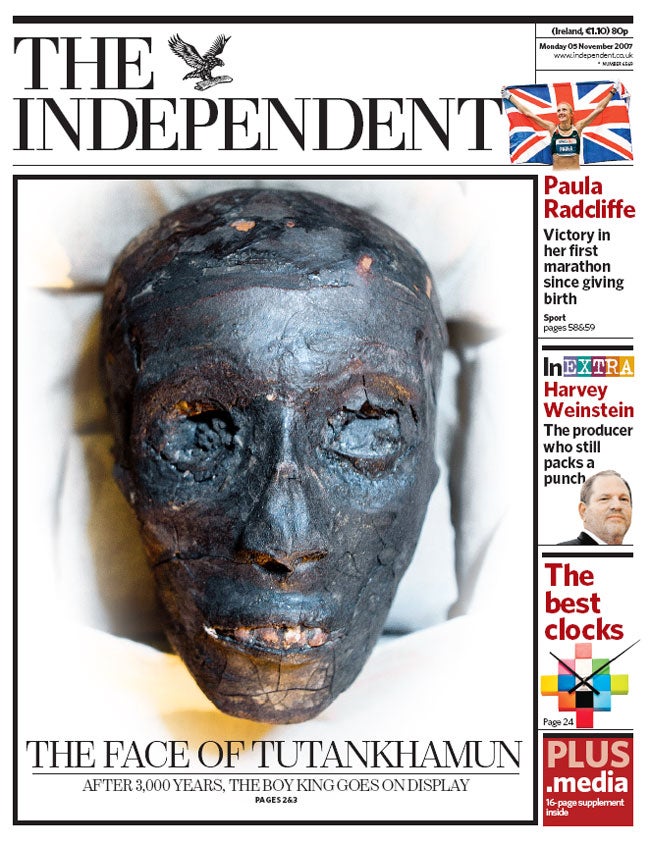3,000 years old: the face of Tutankhamun

The true face of ancient Egypt went on public display for the first time yesterday, as archaeologists unveiled the mummy of the boy pharaoh Tutankhamun.
The golden death mask of the young king, which covered the mummy, has been a familiar image around the world ever since the British treasure-seeker Howard Carter located the tomb in 1922. But, 85 years to the day since Carter's discovery, the actual face of the 19-year-old monarch was put on view in his underground tomb at Luxor, when the linen-wrapped mummy was removed from its stone sarcophagus for display in a climate-controlled glass box.
Naturally, the face the world can now see is a lot less idealised than the lustrous and splendid golden mask. It is shrivelled and leather-like from the embalming process. But, if less idealised, it is a lot more human and exhibits one very human characteristic in particular: he might have been the lord of all he saw, but young King Tut had buck teeth. The mummified face clearly display the "overbite" which was characteristic of the Thurmosid royal line to which Tutankhamun belonged.
Yesterday's display comes at the end of a two-year restoration of the mummy itself, which was badly damaged by Carter and his staff when they removed the death mask and other jewels decorating the body. It was cut into 18 separate pieces in the process. The restoration, supervised by Egypt's head of antiquities, Zahi Hawass, is intended to protect the mummy for the future as there are fears that its condition is deteriorating with mass tourism and the large number of visitors to the tomb.
"The humidity and heat caused by people entering the tomb and their breathing will change the mummy to a powder," said Dr Hawass. "The only good thing [left] in this mummy is the face. We need to preserve the face."
In recent years, many archaeologists have addressed the lingering questions over how Tutankhamun died and his precise royal lineage. Several books and documentaries dedicated to the young pharaoh, who is believed to have been the 12th ruler of ancient Egypt's 18th dynasty and ascended to the throne at about the age of eight, are popular around the world.
Two years ago, scientists removed the mummy from the tomb and placed it into a portable CT scanner for 15 minutes to obtain a three-dimensional image. The results appeared to rule out a violent murder but stopped short of definitively concluding how the young king died in about 1323BC. He did appear to have a fractured left thigh, perhaps caused by a fall from a chariot, and it was thought that he might have died from a subsequent infection, such as gangrene. The CT scan gave many other personal details about him showing that he was well-fed, healthy, yet slightly built, standing at 5ft 6ins at the time of his death.
Dr Hawass said that, along with putting Tutankhamun on display, experts will begin another project trying to determine the pharaoh's precise royal lineage. It is unclear if he is the son or a half brother of Akhenaten, the "heretic" pharaoh who introduced a revolutionary form of monotheism to ancient Egypt and was the son of Amenhotep III.
The mummy will remain in the tomb indefinitely – unlike other Egyptian royal mummies, which are displayed in museums – and tourists will begin viewing the mummy today. The Egyptian tourism industry is hoping to capitalise on the interest and draw tourists to Luxor to see something they couldn't find elsewhere. More than nine million tourists visited Egypt last year – up from 8.7 million the previous year, the Egyptian Tourist Authority said.
"The golden boy has magic and mystery," Dr Hawass told reporters at Luxor yesterday. "Therefore every person all over the world will see what Egypt is doing to preserve the golden boy, and all of them I am sure will come to see him."
Some tourists agreed yesterday. Canadian Bryan Wadson said he and his wife would try to make it back to the Valley of the Kings for the second time today because they missed the unveiling yesterday. But not all tourists agreed. "I really think he should be left alone in quiet, in peace," said Bob Philpotts, a British tourist. "This is his resting place, and he should be left."
John Taylor, an assistant keeper at the British Museum's department of ancient Egypt and Sudan, said tourists would not be the only ones to benefit from putting the mummy on display in a climate-controlled case. "In some ways, it could be advantageous to monitor the condition to see if the mummy is stable," he said.
But Dr Hawass is seeing the whole thing from the public's point of view. "Everyone is dreaming of what he looks like. The face of Tutankhamun is different from any king in the Cairo museum. With his beautiful buck teeth, the tourists will see a little bit of the smile from the face of the golden boy," he said.
Join our commenting forum
Join thought-provoking conversations, follow other Independent readers and see their replies
Comments